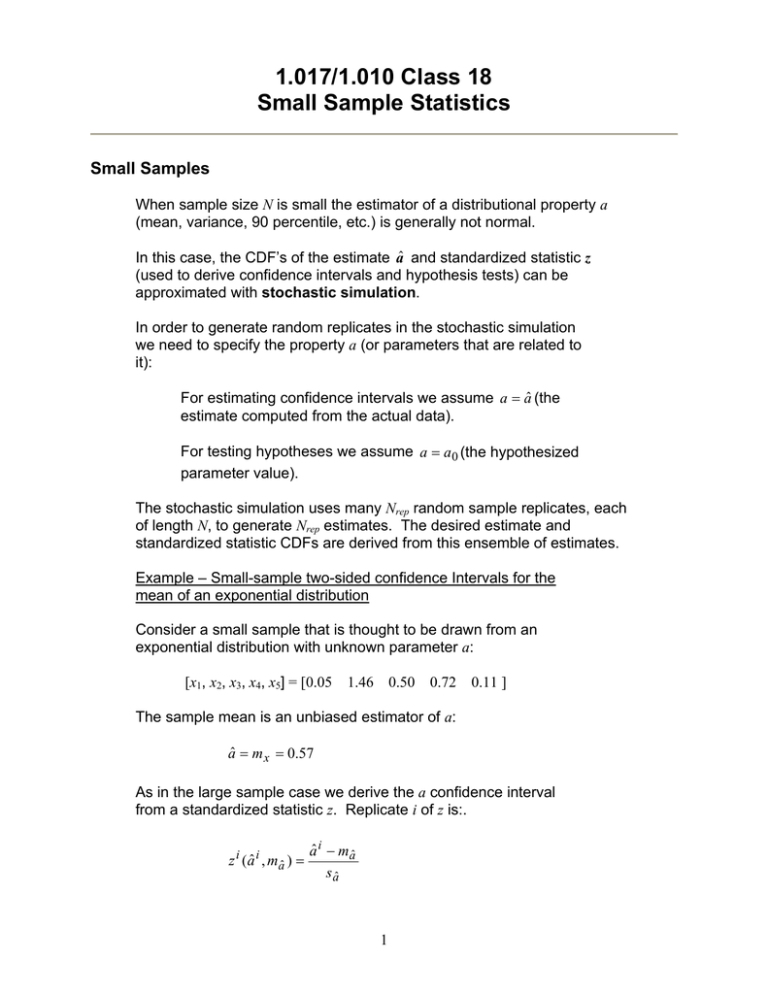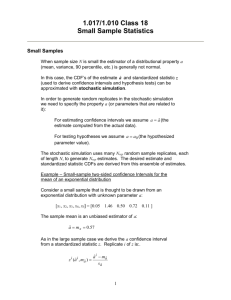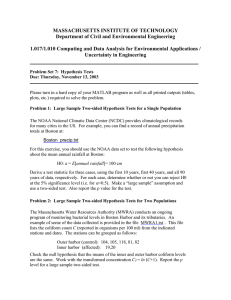1.017/1.010 Class 18 Small Sample Statistics Small Samples
advertisement

1.017/1.010 Class 18 Small Sample Statistics Small Samples When sample size N is small the estimator of a distributional property a (mean, variance, 90 percentile, etc.) is generally not normal. In this case, the CDF’s of the estimate aˆ and standardized statistic z (used to derive confidence intervals and hypothesis tests) can be approximated with stochastic simulation. In order to generate random replicates in the stochastic simulation we need to specify the property a (or parameters that are related to it): For estimating confidence intervals we assume a = aˆ (the estimate computed from the actual data). For testing hypotheses we assume a = a0 (the hypothesized parameter value). The stochastic simulation uses many Nrep random sample replicates, each of length N, to generate Nrep estimates. The desired estimate and standardized statistic CDFs are derived from this ensemble of estimates. Example – Small-sample two-sided confidence Intervals for the mean of an exponential distribution Consider a small sample that is thought to be drawn from an exponential distribution with unknown parameter a: [x1, x2, x3, x4, x5] = [0.05 1.46 0.50 0.72 0.11 ] The sample mean is an unbiased estimator of a: aˆ = m x = 0.57 As in the large sample case we derive the a confidence interval from a standardized statistic z. Replicate i of z is:. z i (aˆ i , maˆ ) = aˆ i − maˆ s aˆ 1 where maˆ and s aˆ .are the sample mean and standard deviation computed over the ensemble of all estimate replicates aˆ i (e.g. i = 1,…, Nrep). Each â i is derived from N = 5 data values obtained from the MATLAB function exprnd, with a = m x = 0.57 . The CDF Fz(z) is obtained by plotting the zi replicates with cdfplot or normplot. Fz(z) for this example clearly deviates from the unit normal at both high and low values: p/2 z zL zU Fz(z) is used as in the large sample case to identify the zL and zU values: α z L = FZ−1 2 α zU = FZ−1 1 − 2 The small-sample double-sided 95% confidence interval for a is approximately: a L = aˆ − zU s aˆ = 0.56 - (+2.1)(0.255) = 0.02 aU = aˆ − z L s aˆ = 0.56 - (-1.5)(0.255) = 0.94 0.02 ≤ a ≤ 0.94 For comparison, the 95% doubled-sided large-sample (normal) interval: 0.06 ≤ a ≤ +1.06 2 The difference is slight considering the small sample size. The difference in the small and large-sample 99% confidence intervals is greater. Example – Small-sample two-sided test of a hypothesis about the mean of an exponential distribution Consider in the above example the hypothesis: H0: a=1.0 We can derive the rejection region and p value for this hypothesis with a stochastic simulation similar to the performed above except that we use a = a0 =1.0 in exprnd and derive Fz(z) from replicates defined as follows: aˆ i − a0 aˆ i − 1.0 i ˆi z (a , a0 ) = = s aˆ s aˆ In this case the Fz(z) plot is the same as the one shown above. The test statistic obtained from the observed sample mean is: z (aˆ , a0 ) = aˆ − a0 0.56 − 1.0 = = −1.73 s aˆ 0.255 This gives a p value of approximately 0.004 (see figure), leading us reject the hypothesis. Special Case: Normally Distributed Samples If random sample(s) are normally distributed it is possible to derive the exact small sample CDFs of certain standardized statistics Two-sided Confidence Intervals for Small Normally Distributed Samples Confidence Intervals for the Mean E(x): Standardized statistic: t (m x , a) = mx − a sx N This has a t distribution with n=N-1 degrees of freedom. Confidence interval: 3 α s α s m x − Ft−, ν1 1 − x ≤ a ≤ m x − Ft−, ν1 x 2 N 2 N Evaluate Ft−,ν1 with MATLAB function tinv. Confidence Intervals for the Variance Var(x): Standardized statistic: χ 2 ( s x2 , σ x2 ) = ( N − 1) s x2 σ x2 This has a Chi-squared distribution with ν =N - 1 degrees of freedom. Confidence interval: ( N − 1) s x2 ( N − 1) s x2 ≤ Var[ x ] ≤ α α F χ−21,ν 1 − F χ−21,ν 2 2 Evaluate F χ−21,ν with MATLAB function chi2inv. Two-sided Hypothesis Tests for Small Normally Distributed Samples Hypothesis Tests about the Mean E(x): H 0 : E ( x) = a0 Use t test statistic (ν = N -1) : t (m x , a 0 ) = m x − a0 sx N p value: p = Ft , ν [t (m x , a0 )] for Ft , ν ≤ 0.5 2 p 1 − = Ft , ν [t (m x , a0 )] for Ft , ν > 0.5 2 Evaluate Ft , ν with MATLAB function tcdf. Hypothesis Tests about the Variance Var(x) 4 H 0 : Var ( x) = σ x2 = a0 Use Chi - squared test statistic (ν = N -1) : χ 2 ( s x2 , a0 ) = p = F χ 2 ,ν [ χ 2 ( s x2 ,a0 )] for F χ 2 ,ν ≤ 0.5 2 p 1 − = F χ 2 ,ν [ χ 2 ( s x2 ,a0 )] for F χ 2 ,ν > 0.5 2 Evaluate Ft , ν with MATLAB function chi2cdf. t CDF ν= ν=1 Chi-squared ν=4 ν = 10 Copyright 2003 Massachusetts Institute of Technology Last modified Oct. 8, 2003 5 ( N − 1) s x2 a0




